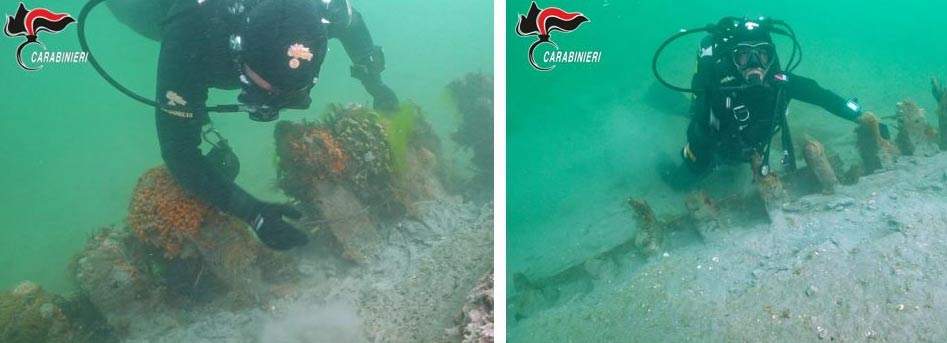Important discovery in Friuli-Venezia Giulia by the Carabinieri of the Nucleo Tutela Patrimonio Culturale in Udine: as part of a periodic check of submerged archaeological sites between Grado (Gorizia) and the Mouths of the Timavo, and in particular during monitoring activities at the site known as “Grado 2,” the wreck of a Roman-era vessel never before surveyed was found. This is a site that had previously returned a wreck (a boat from the 3rd century B.C., found in 2000 about 7 nautical miles from Grado and at a depth of 19 meters, along a route that connected this area to the rest of Italy and Greece).
The newly discovered vessel lies at a depth of about 5 meters and is mostly buried, although from observation of the exposed parts it has been ascertained that the craft was built using a particular technique, called “mortise-tenon” (an interlocking joint with a male element called a “tenon” and a female accommodation called a “mortise”). The portion of the hull visible today has a length of 12.20 meters measured from the “gum” of the channel, but given the conformation of the exposed wood it could be at least twice as long and an estimated width of no less than 8 meters. First analyses clearly noted the ordinates of the width of about 15 cm and the planking boards of at least 6 cm.
According to archaeo-subaquatic experts from the Soprintendenza Archeologia, Belle Arti e Paesaggio del Friuli Venezia Giulia and theUniversity of Udine, this is “a discovery of exceptional historical importance for the area of the upper Adriatic Sea. ”Preliminary analyses were carried out personally by the technicians at the spot indicated to them by the Carabinieri Subacquei of Genoa, who had noticed the outline of the wreck drawing the attention of the specialists. The activity continued at the Canale delle Mee in Grado, the historic entrance to the river port of Aquileia, with the discovery of two acephalous amphorae type “Lamboglia 2” having measurements 60 x 35 cm, dating back to the 1st century B.C., as well as a jug neck and an amphora neck dating back to the 2nd-3rd century A.D.
The wreck will be the subject of future archaeological investigations by the aforementioned Superintendency in collaboration the University of Udine aimed at securing and protecting it, as well as at deepening the historical understanding of Grado’s function as the maritime hub of Aquileia, at that time the fourth largest Italian city of the Roman Empire: it had about 100.000 inhabitants, it was the capital of the X Regio Venetia et Histria, and was at the center of the great commercial trades that from the northern borders of Noricum and Pannonia reached the sea to develop throughout the Mediterranean and vice versa, in analogy to what Ostia represented for ancient Rome.
The activity described above enables the Carabinieri to protect underwater archaeological sites that are subjected to natural environmental stress, the constant threat of unregulated fishing and underwater activity aimed at theillicit appropriation of the submerged cultural heritage and, as in this specific case, to discover the existence of artifacts from different periods through which to deepen the historical knowledge of the area encompassed between Grado and the Mouths of the Timavo River.
 |
| Friuli-Venezia Giulia, Carabinieri discover Roman shipwreck in Grado waters |
Warning: the translation into English of the original Italian article was created using automatic tools. We undertake to review all articles, but we do not guarantee the total absence of inaccuracies in the translation due to the program. You can find the original by clicking on the ITA button. If you find any mistake,please contact us.